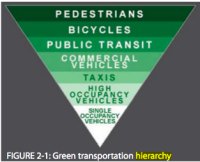
The Portland Business Alliance released their letter on the Portland Bicycle Plan for 2030 today.
The six-page letter signed by CEO Sandra McDonough on behalf of 1,400 businesses expresses support “of the overall goal” of the plan but also calls out some concerns and offers several suggestions.
The PBA (download PDF here) calls the plan’s goal of 25% bike usage “unrealistically high” and questions the wisdom of emulating cities like Amsterdam and Copenhagen.
There is also trepidation from the PBA that the plan is anti-car, or as they put it:
“At times, the plan appears to call for prioritizing investment in pedestrian and bicycles over other modes and uses, potentially undermining the city’s successful multi-modal strategy. The plan’s call for creating a bike district in downtown raises questions regarding the multi-modal transportation needs of the central city…”
Here two other suggestions to improve the plan, compliments of the PBA:
- The plan should contain performance measures for investments in bike facilities to determine whether they achieve the objectives set out to secure funding approval.
- Oregon’s long-standing user-pay philosophy should extend to bicycling if it is going to be a significant user of the right-of-way and impetus for significant capital expenditures.

Not surprisingly, the PBA offered detailed comments on one aspect of the plan in particular, the Green Transportation Hierarchy. As I reported back in October, that heirarchy would “radically shift how the City approaches street designs, putting human-powered modes at the top and placing single-occupancy vehicles at the bottom.”
Here’s what the PBA thinks about it:
“We support balancing the role of each mode in meeting the city’s mobility and access needs. Therefore, we are concerned about the plan’s Green Transportation Hierarchy, which we read to call for prioritizing investment in pedestrian and bicycle infrastructure over transit and commercial auto needs. While the Alliance agrees that investing in alternative modes to auto is critical to reducing congestion and maintaining capacity, the plan cannot undermine the need to maintain the infrastructure that supports freight and commercial vehicles…
We urge that investments made in pedestrian and bicycling modes will be considered in coordination with other modes with the intention of improving the overall operation of the transportation system, and we encourage added language making that clear.”
The detailed letter also touches on “bicyclists who do not know – or choose not to obey – traffic rules:”
“The Alliance suggests that bicyclists be required to demonstrate knowledge of the traffic laws just as other direct users of the right of way must do.”
And they feel it’s time that people who ride bikes start to pay their way:
“Also, if this city is serious about significantly increasing bicycle mode share, it is unavoidable that bicycles be asked to share some of the burden of paying for the infrastructure they use. While their per-unit burden on the system is low relative to other modes, it is not zero – particularly when significantly expanded facilities are being constructed, or parking stalls are removed and their associated city revenue are foregone… We ask that you extend the user-pay philosophy to bicycling.”
It’s important to remember two things when reading this letter: First, the PBA has, in the past, been something of an arch-rival to bike planners and bike advocates in this city; and second, the PBA carries a considerable amount of political weight in Portland.
This letter offers a fascinating (if you’re a wonk) perspective on how an historically non bike-friendly business association reacts to a major bike plan. I think the depth of thought and consideration taken on it shows a lot of promise for future discussions with the PBA on how to make biking work better for everyone in Portland.
— Download the letter (PDF)

